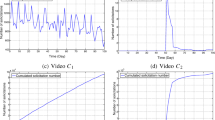Abstract
Content Delivery Networks (CDNs) distribute most data traffic nowadays by caching the contents in a network of servers to provide users with the requested objects, and hel** to reduce latency when delivering contents to the user. The content caching system performance depends upon many factors such as where the objects should be stored, which object to store, and when to cache them. The proposed methodology includes two main phases: an admission control phase and a cache replacement phase. The admission control phase is responsible for accepting or rejecting the incoming request based on training the Reinforcement Learning (RL) algorithm to make the best decision in the near future to maximize its reward, which, in this case, is the hit ratio. The cache replacement phase estimates the object’s future popularity. This is achieved by building a predictive model based on the popularity prediction mechanism, where the Long-Short-Term Memory (LSTM) model is used to compute the object’s popularity. The LSTM model’s outcome can help decide which objects to cache and which objects to evict from the cache. The proposed methodology is tested on a dataset to demonstrate its effectiveness in enhancing the hit ratio compared to conventional replacement policies such as First-in-First-Out (FIFO), Least Recently Used (LRU), Least Frequently Used (LFU) and a recent machine learning-based algorithm. The experimental results on the dataset revealed that the proposed methodology outperformed the baseline algorithms by 34.7% to 97.17% with a cache size of 130.
















Similar content being viewed by others
Data availability
Enquiries about data availability should be directed to the authors.
References
Sadeghi, A., Wang, G., Giannakis, G.B.: Deep reinforcement learning for adaptive caching in hierarchical content delivery networks. IEEE Trans. Cogn. Commun. Netw. 5(4), 1024–1033 (2019)
Zhao, Y., Zhang, X., Yang, K., Fan, Q., Guo, D., Lyu, Y., Ma, Z.: Caching Salon: From classical to learning-based approaches. In 2019 IEEE International Conference on Service-Oriented System Engineering (SOSE), 269–2695 (2019)
Thar, K., Tran, N.H., Oo, T.Z., Hong, C.S.: DeepMEC: mobile edge caching using deep learning. IEEE Access 6, 78260–78275 (2018)
Niyato, D., Kim, D.I., Wang, P., Bennis, M.: Joint admission control and content caching policy for energy harvesting access points. In 2016 IEEE International Conference on Communications (ICC), 1–6 (2016)
Kirilin, V., Sundarrajan, A., Gorinsky, S., Sitaraman, R.K.: RL-Cache: learning-based cache admission for content delivery. IEEE J. Sel. Areas Commun. 38(10), 2372–2385 (2020)
Guan, Y., Zhang, X., Guo, Z.: CACA: Learning-based content-aware cache admission for video content in edge caching. In Proceedings of the 27th ACM International Conference on Multimedia, 456–464 (2019)
Zhong, C., Gursoy, M.C., Velipasalar, S.: A deep reinforcement learning-based framework for content caching. In 2018 52nd Annual Conference on Information Sciences and Systems (CISS), 1–6 (2018)
Wang, C., Gai, K., Guo, J., Zhu, L., Zhang, Z.: Content-centric caching using deep reinforcement learning in mobile computing. In 2019 International Conference on High Performance Big Data and Intelligent Systems (HPBD&IS), 1–6 (2019)
Narayanan, A., Verma, S., Ramadan, E., Babaie, P., Zhang, Z.L.: DeepCache: A deep learning based framework for content caching. NetAI 2018 - Proceedings of the 2018 Workshop on Network Meets AI and ML, Part of SIGCOMM 2018, 48–53 (2018). https://doi.org/10.1145/3229543.3229555
Zhang, R.X., Huang, T., Wu, C., Sun, L.: Reactive video caching via long-short-term fusion approach. http://arxiv.org/abs/1905.06650 (2019)
Pang, H., Liu, J., Fan, X., Sun, L.: Toward smart and cooperative edge caching for 5G networks: A deep learning based approach. In 2018 IEEE/ACM 26th International Symposium on Quality of Service (IWQoS), 1–6 (2018)
Gharaibeh, A., Hababeh, I., Alshawaqfeh, M.: An efficient online cache replacement algorithm for 5G networks. IEEE Access 6, 41179–41187 (2018)
Fan, Q., Li, J., Li, X., He, Q., Fu, S., Wang, S.: PA-Cache: learning-based popularity-aware content caching in edge networks. Ar**v Preprint Ar**v: 2002.08805 (2020)
Zong, T., Li, C., Lei, Y., Li, G., Cao, H., Liu, Y.: Cocktail edge caching: Ride dynamic trends of content popularity with ensemble learning. Ar**v Preprint Ar**v, 2101.05885 (2021)
Li, S., Xu, J., Van Der Schaar, M., Li, W.: Popularity-driven content caching. In IEEE INFOCOM 2016-The 35th Annual IEEE International Conference on Computer Communications, 1–9 (2016)
Zhang, Y., Li, Y., Guo, W., Huo, L., Zhang, J., Guo, K.: Single-choice aided marking system research based on back propagation neural network. J. Cybersecur. 3(1), 45 (2021)
Yang, T., Zhang, S., Li, C.: A multi-objective hyper-heuristic algorithm based on adaptive epsilon-greedy selection. Complex Intell. Syst. 7(2), 765–780 (2021)
López, A.D.: Zipf extensions and their applications for modeling the degree sequences of real networks. (Doctoral dissertation, Universitat Politècnica de Catalunya (UPC)) (2021)
Funding
The authors declare that no funds, grants, or other support were received during the preparation of this manuscript.
Author information
Authors and Affiliations
Contributions
All authors contributed to the study conception and design. Material preparation, data collection and analysis were performed by LA, IA and SA. The first draft of the manuscript was written by LA and all authors commented on previous versions of the manuscript. All authors read and approved the final manuscript.
Corresponding author
Ethics declarations
Competing interests
The authors have no relevant financial or non-financial interests to disclose.
Additional information
Publisher's Note
Springer Nature remains neutral with regard to jurisdictional claims in published maps and institutional affiliations.
Rights and permissions
Springer Nature or its licensor (e.g. a society or other partner) holds exclusive rights to this article under a publishing agreement with the author(s) or other rightsholder(s); author self-archiving of the accepted manuscript version of this article is solely governed by the terms of such publishing agreement and applicable law.
About this article
Cite this article
Abdo, L., Ahmad, I. & Abed, S. A smart admission control and cache replacement approach in content delivery networks. Cluster Comput 27, 2427–2445 (2024). https://doi.org/10.1007/s10586-023-04095-7
Received:
Revised:
Accepted:
Published:
Issue Date:
DOI: https://doi.org/10.1007/s10586-023-04095-7




